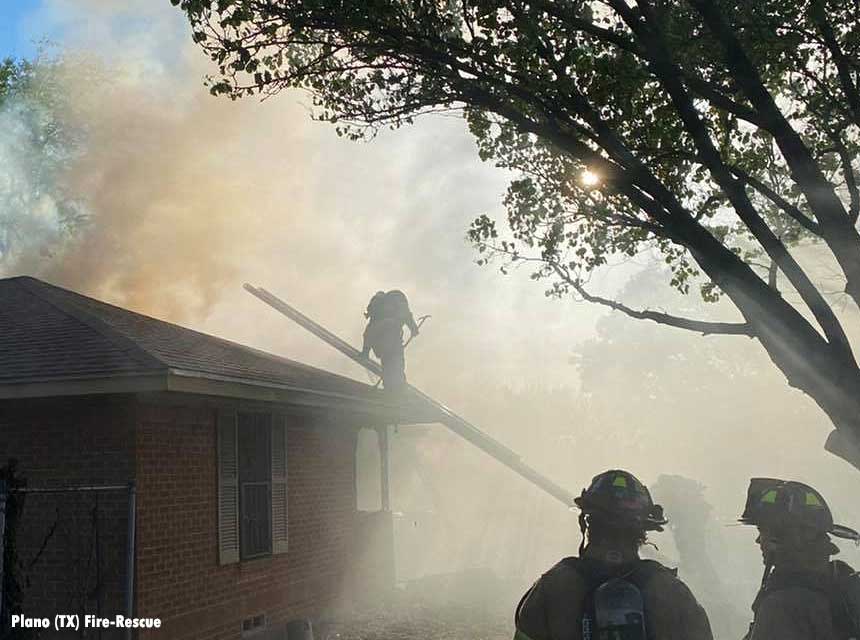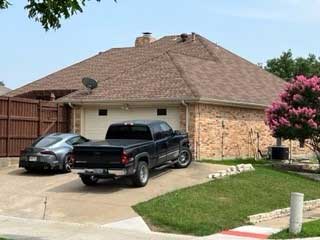
By Eric Wahlberg
Horizontal ventilation in many departments has become a lost tactic. UL’S Fire Safety Research Institute (FSRI) recommends horizontal ventilation pre-suppression through vent-enter-search (VES) or targeted search and post-suppression to quickly clear the interior space and return survivable atmospheres. So why isn’t it done more often? I believe it’s mainly due to the misapplication of the FSRI findings from the initial studies that emphasized controlling exterior openings to limit the growth and flow path of the fire. Controlling openings is certainly warranted for fires in living, spaces but garage and attic fires are generally compartmented from the interior space.
- Getting the Most from Horizontal Ventilation
- Ray McCormack: Venting Windows
- Training Minutes: Taking Windows and Horizontal Ventilation
- Truck Company Ops: Taking the Window
Fire data from the City of Plano/Plano (TX) Fire Rescue shows that 80 percent of fires in large modern homes start in the garage, attic, or exterior of the house into the attic space. Think Inside the Box tactics compartment the interior, garage and attic from each other because that is how they are built. Basically, fire in one box doesn’t mean you have fire in all three. A fire in the garage and attic, with the interior garage door intact, has no direct access to the front door or windows of the home, therefore opening the door or taking the windows can’t affect the growth and flow path of the fire. Understanding this, and applying the proper tactics, allows firefighters to quickly clear the interior box, complete primary search, and provide visibility for interior operations. For more detailed information, refer to Think Inside the Box: Ventilation and Flow Path in Modern Homes.

The Interior Box
This is any fire where the main body of fire originates or extends into the living space. My normal action is to split my truck crew into two teams. Here are my priorities:
- Access
- Targeted search
- Horizontal ventilation
- Primary search
- Vertical ventilation
- Overhaul and salvage
Access for the engine is the most important job on the fireground because getting effective water on the fire removes the energy from the fire, reduces temperatures and toxic gases throughout the structure, and allows rapid horizontal ventilation.
VES is the preferred tactic for search primarily because firefighters drop right into one of the most likely spots to find victims and are horizontally venting at the same time. This can also be accomplished through traditional search from the door, but targeted search may be the better option . If you choose a traditional search, go for the bedrooms first, close doors behind you, and immediately vent the window. Conditions will lift quickly, so most of the search will be by sight. Leave the door open on the way out if it improves conditions in the hallway. If suppression is in place leave it open and continue. FSRI data on this is clear—isolate spaces until suppression (effective water) is in place, then rapidly open up.
Horizontal ventilation is my preferred method to ventilate the interior box. Locate the seat of the fire and coordinate with the engine before taking the window or door. Always vent in front of the advancing line. When the line opens up with effective water on the fire, quickly open up the living areas and transition to primary search.
Primary search is defined as the rapid and systematic search for victims. I’m sure there are many people questioning my priorities or why the primary isn’t #1 or #2. To me, it’s semantics. The targeted search begins the primary search process, but I wanted to separate them out to make a specific point. These houses aren’t 800-1,000 square feet. A quick Internet search says the average home in Texas is 2,170 square feet, and since Plano is an upper middle-class city, I would say the average size is bigger. Many are open concept two-stories, more than 3,000 square feet. My point is that you can crawl around in one of these large homes all day long and not touch all of it in zero visibility. We have had multiple primary searches in large homes that took over 15-20 minutes because of zero visibility. This is due to the lack of horizontal ventilation, even when the main body of fire was knocked down shortly after arrival. A 20-minute primary search isn’t saving anyone. The only way to effectively search larger homes is with targeted search, horizontal ventilation, and effective water on the fire.
Split your crew and start the primary search with a targeted search of one of the bedrooms while you vent for the attack, and then take the windows quickly once the line is in service. If the line is in service first, just open up.

Vertical ventilation is used by many departments as their default ventilation tactic for just about every fire. I prefer to ventilate interior fires through horizontal ventilation, and attic fires through the roof when conditions allow. With interior fires, when I am first due, I will usually split my crew and do targeted search and horizontal ventilation. If vertical ventilation is needed, I will either assign it to the second-due truck or transition to vertical ventilation myself once the horizontal ventilation is effective. If we have fire in the interior box, we must address it first, even if we have fire in the attic. Keep in mind that a large number of these homes have roofs that aren’t able to be vertically ventilated to effectively vent the interior box due to pitch and sheer size. Even when the roof is walkable, though, VES combined with horizontal ventilation is quicker, more effective, and doesn’t expose a large attic space to fire conditions.
Overhaul and salvage starts as soon as possible after the priority objectives are completed. Overhaul includes access for the engine to the attic space to address fire that has extended or just getting to hot spots. I’ve heard and read comments within my own organization, as well as online, that say something to the effect of salvage being a lost art or we have to do better, etc. When operating as the first- or second-due truck, and my goals of primary search and ventilation have been met and there are no attic issues pressing or other considerations, I will address salvage. Our next installment will deal with the garage box in single-story modern homes.
Garage Box
Since I stated previously that the Garage Box is where the majority of working fires originate in the City of Plano, I like to concentrate most of my attention in-station training on fires in the garage box for two reasons. First, this is a likely scenario today. If we get toned out for a fire, any training we do on this scenario is likely to be reinforced on the fireground. Second, this can be applied as a standard tactic for garage fires with high success rates.
My objectives remain the same in this scenario:
- Access
- Targeted search
- Horizontal ventilation
- Primary search
- Vertical ventilation
- Overhaul and Salvage
Access to garages in Plano are generally from the rear of the house. Gates, fences, pools, dogs, garage doors, cars involved in the driveway, and carports are some of the potential issues that delay access. Remember, the truck is providing access for the engine company so they can get effective water on the fire. For garage fires, or any other fires showing from the rear of the structure, our crews stretch a 2.5-inch line to the rear and knock down the main body of fire. The next-due companies will make entry and handle the interior. That doesn’t mean standing at the end of the driveway lobbing water into the garage. The engine company must be positioned at the garage door with most of the water penetrating the attic space once the main body of fire is knocked down. For the first 10 years of my career, garage fires were always attacked from the front door because we were expected to attack from the unburned side. This was so we didn’t “push fire” into the structure.

Since there was almost always fire extension to the attic with well-involved garage fires, companies pulled ceiling immediately upon entry, which only made the interior conditions worse. Horizontal ventilation was rarely done, and vertical ventilation was sometimes done, unless fire was already through the roof. In fact, if fire was through the roof on arrival, the first company usually said the fire was vented as a part of the size-up, with no consideration for the interior conditions. At some point it dawned on me that the attic fire couldn’t be addressed until the main body of the fire in the garage, which was feeding the attic fire, was knocked down. We often set positive pressure fans, because if fire was through the roof over the garage, we should be able to push that smoke out the vent but that never worked either because the interior door to the garage was usually intact. Once I finally figured out that the interior, garage, and attic spaces were separate compartments and needed to be addressed as such, things started making sense. I started advocating for exterior blitz attacks for garage fires and began to ventilate the interior box using horizontal ventilation. Getting effective water on the main body of the fire is the most important job on the fire ground. FSRI has shown that conditions improve throughout the structure with the application of effective water, and the active effects of flow path stop, allowing you to quickly open up the structure. “The fire goes as the first line goes” is probably the truest statement ever made about fireground operations. The first-due truck must ensure access for that first line to get control of the fire. That allows us to vent and control the interior box, complete the primary search, then deal with the attic fire detailed below.
Targeted search will focus on the bedrooms. I will split 2/2 targeted search/horizontal vent, and then assign the second-due truck to targeted search or targeted search/vertical ventilation. If the fire isn’t already through the roof, and we have the garage knocked down and we are ready to address the attic, either I will transition to the roof, once the horizontal vent is effective, or split the second due truck VES/vertical vent. The search is going to go quickly in most cases, so by the time the primary search is completed, the search teams can immediately transition to pulling ceiling for the engine.
Horizontal ventilation is the quickest and easiest way to address ventilation. Since we have a garage fire (no fire or active flow path in the interior box), we can open up very quickly. Targeted search teams assist this process, too. If you have doubts as to whether fire has burned into the interior box, wait until effective water is on the fire. Effective water on the fire is the safety valve for ventilation.
So how do you know if you have fire extended into the interior box? Indicators may include pressurized smoke conditions from openings and signs of heat on glass closest to the garage like crazing, melted shades, and severely discolored glass. Your thermal imaging camera can’t see through glass but will show heat transmitted through the glass. In a typical construction with the garage on the side with the kitchen, position your outside vent (OV) firefighter at the rear door and windows in the middle of the house, and the officer at the kitchen windows. Prior to fire suppression, when fire has extended from the garage box to the interior box, the OV firefighter should force the rear door and get a search in the rear of the house (“hook and look”), staying anchored to the door. Pets are frequently found near rear doors, where they are used to going outside, and people can always be found in a main egress, although they tend to be found toward the front. Once the search is done, the OV firefighter controls the door until water is on the fire. Once you have effective wateron the main body of fire, horizontally ventilate the back of the house quickly. At the same time, the officer will take the kitchen windows and any other large openings on the side. With targeted search hitting the bedroom windows on the side and/or front of the house, you shouldn’t need more than the front door open and a front window ventilated to clear the space. When fire has not extended to the interior box from the garage box, the OV firefighter should just open the door and take the windows, and then grab the search. The officer can ventilate the kitchen side of the house. If there is no fire in the house (interior box), there is no active flow path, and therefore little risk of hostile fire events or spreading the fire to the interior boxwith horizontal ventilation.
Primary search begins through the targeted search. The primary search is completed as the house clears, searching larger common areas by sight. If the interior space does not clear, multiple two firefighter teams should be finishing targeted search that can assist with larger areas.
Vertical ventilation is indicated for garage fires that extend to the attic and have not vented on their own. The main body of the fire should be knocked down with the blitz line from the exterior, then direct the line into the attic space. Often the 2.5-inch has laid the attic fire down before the engine makes access from the interior. Before cutting a hole, we also need an attack line in operation in the attic. If conditions allow, make the first cut over the garage and then come back and cut a hole over the engine’s position inside. Since the engine needs to be above the top plate with the line, a hole in the area of where they are set up—to lift some of the heat so they can operate more effectively—can make conditions much better for the engine. In most modern homes, the garage is on the living area side of the house. Engine companies should position in one of the living area rooms, preferably the first room off the entry on that side to access the attic. Use a ladder and get waist deep in the attic so your stream is horizontal in the attic for maximum effectiveness. When the garage is on the bedroom side of home, instead of going through the front door, down the hallway, and back toward the front of the home to access from the bedroom, consider just going through the window. If the window is still intact, assume the room hasn’t been searched and isolate the room by closing the door before searching it, then access the attic. Leave the door closed to access the attic.
Overhaul and salvage are the same as before. Transition into overhaul when the search/vent is completed and then address salvage.

Attic Box
Attic fires can either be extended from an interior or exterior fire at the home, or fires can start in the attic. Lightning, electrical shorts, and plumbers are some of the causes. The attics in modern homes are usually very large. I have some small volume attics on flatter, 4/12 pitch, but most are 6/12 pitch and greater that require a lot of water.
Modern homes also have giant hip attics that are 10/12 pitch or steeper. Some of the steep hip-style roofs have an attic box that has more volume than the interior and garage boxes combined, and the peak can be 20 feet above the top plate. To have any chance at these large-volume attics, horizontally ventilate the interior box prior to pulling the ceiling or otherwise accessing the attic. You also need multiple lines or a 2.5 plus a backup. The best-case scenario is to get a line flowing into the attic from the soffit or through the ceiling just inside a front window while the trucks get the vent and targeted search going. Positive pressure fans may be needed to force the smoke out and get a foot hold. Remember, the interior box and attic box are separate spaces until we pull the gypsum board or drop the ceiling with water. Large attics produce large quantities of smoke/fuel when they are vent-limited and produce zero visibility conditions inside. Once they burn through or are vertically vented, unless we already have significant water in the attic, we generally cannot overcome the heat and pressure that has built up in the attic from the inside with handlines; defensive operations ensue. Prior to horizontal ventilation, a solid 360 is required to ensure what looks like an attic fire didn’t start inside the house. Once we have water in the attic, employ vertical ventilation to support fire attack for vent-limited attic fires.
Truck objectives are as follows:
- Targeted search
- Horizontal ventilation
- Access
- Vertical ventilation
- Overhaul and salvage
Targeted search jumps to the front of the line of priorities here since we are hoping to get effective watergoing from the soffit or ceiling inside a front window. A large, ventilation-limited attic will be forcing heat and gases through any interior accesses like HVAC vents and can lights, etc. While isolating any space accessed for targeted search is recommended prior to suppression, since there is no fire inside the living space, open the door and continue the search from the interior, remembering to vent as you go. I recommend a minimum of three two-man teams to clear the space more quickly for large homes.
Horizontal ventilation will be taking place at the same time as targeted search. The officer and OV will perform a 360, confirming the attic fire, and then move to open up the main body of the house. Positive pressure fans can be used to establish a front door to rear of the home flow path and maintain visibility, since access to the attic is usually from one of the living areas. Be flexible and work the ventilation profile until you get what you want. Although command will be in charge, as the officer in charge of ventilation you should be coordinating with attack and search companies to complete the primary search and ventilation and move the attack inside.
Access by attack companies initially should be from the outside, especially for large attic spaces. Smaller attics with walkable pitched roofs are easier to control with handlines because they produce less smoke and heat. Ventilation-limited attic fires are generally primed for hostile fire events and just require the right mix of oxygen to do their thing. David Dodson talked about ladder fuels in ventilation-limited spaces. These are gases that can auto-ignite at as low as 400°, causing the next gas to ignite and the next, culminating with CO, the most prevalent fire gas, at around 1100°. Frank Brannigan also talked about the danger of CO buildup in concealed spaces, offering a couple of dramatic examples. Effective water applied to the space from the soffit, prior to accessing it by pulling a bunch of ceiling, will cool the entire attic space and greatly reduce the chances for a hostile fire event. For large, single-story hip attics, getting big water into the attic for a minute or two may buy time to establish a water supply and advance the line into the house. Since the sides of a hip roof all slant into a much smaller ridgeline, using the underside of the roof deck like a deflector on a sprinkler head may provide good coverage in the attic.
The power of the 2.5 may also blow through any weakened decking, providing some vertical ventilation as water cools the space.

Vertical ventilation is needed for attic fires that are not already through the roof. If you cut the roof without effective water in the attic, most of the attic will flash immediately. If you pull ceiling for attack prior to cutting the hole, those conditions will take the path of least resistance and pour into the interior. It’s the catch-22 of attic fires. With advanced fire conditions in the attic, you must have water in the attic when you open the roof, whether from the soffit or ceiling. Remember, I’m not talking about low-pitch, small-volume attics. These are large spaces that, when heavily involved, require lots of water to control. You can’t treat a 2000-plus-square-foot house with a 10/12 pitch roof the same as a 3/12 pitch, 2,000-square-foot house. Effective water applied in the attic changes the visible smoke conditions for the better, and vertical ventilation over the interior attack companies should allow them to get up into the attic for extinguishment. Coordination between ventilation and attack crews is vital.
Overhaul and salvage takes place after search and ventilation are completed and the engine company has access to attack the attic fire. In many cases, salvage can often be accomplished before most, or all, of the ceiling is down, and most of the overhaul is accomplished hydraulically.
In the third and final installment, we consider tactics for modern two-story homes.
Eric Wahlberg is a 28-year veteran of Plano (TX) Fire Rescue and is a captain/paramedic assigned to Truck 2 on C Shift. He is a Master Firefighter with the state of Texas and holds numerous other certifications with the state. As a firefighter he has served on the special rescue and hazmat teams and was a flight medic for almost two years.

